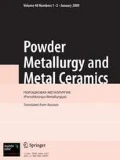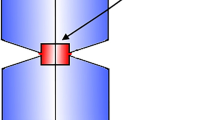X-ray diffraction revealed that the ZrNi1.2Mn0.5Cr0.2V0.1 alloy powder exposed to air showed quantitative surface phase composition of varying stability depending on the weight of samples. When a powder sample with a lower weight (5 g) was exposed to air for two days, its quantitative phase composition was quite stable and varied within 1%, while a powder sample with a greater weight (40 g) had polymorphic C15 and C14 phases (amount of the C15 phase became 4% higher and that of the C14 phase became 4% lower). The sample that was more stable in exposure to air for two days demonstrated a greater cyclic life in the hydrogeneration–dehydrogenation process. The quantitative phase composition of the lighter sample exposed to air was assumed to be also stable in the hydrogenation–dehydrogenation process and to promote a greater cyclic life, while changes in the quantitative phase composition affected the cyclic life. The activation of electrodes compacted from freshly made ZrNi1.2Mn0.5Cr0.2V0.1 alloy powders depended on the type of nickel and manganese used for melting and occurred at different rates. In the case of electrolytic nickel and electrolytic manganese in alloy melting (40 g samples), the maximum discharge capacity was reached six cycles sooner than in the case of cathode nickel and ferromanganese. Contrastingly to the activation rate, the cyclic life of electrodes made of the ZrNi1.2Mn0.5Cr0.2V0.1 alloy powders using different types of nickel and manganese primarily depended on the weight of the samples. The cyclic life curves for the electrodes pressed from freshly ground powders from the 5 g alloy samples (cathode nickel and ferromanganese in one sample and cathode nickel and electrolytic manganese in the other sample) matched. The cyclic life curves for the electrodes made of the 40 g samples (cathode nickel and ferromanganese in one sample and electrolytic nickel and electrolytic manganese in the other sample) matched as well. The best cyclic life was demonstrated by the electrodes made of the lighter powder samples. This was likely to be associated not only with the sample sizes but also with the use of cathode nickel in alloy melting. The loss of discharge capacity by these electrodes for 80 cycles was 8%, while that for the electrodes made of the powders ground from the heavier samples was 50%.






Similar content being viewed by others
References
Yu.M. Solonin, O.Z. Galiy, E.A. Graivoronskaya, and V.A. Lavrenko, “Electrochemical properties of ZrMnCrNiV alloy in long-term cycling after air oxidation,” Powder Metall. Met. Ceram., 56, No. 9–10, 567–572 (2018).
Yu.M. Solonin, O.Z. Galiy, K.O. Graivoronskaya, A.V. Samelyuk, and S.S. Petrovska, “Effect of air exposure of the Zr–Mn–Cr–Ni–Al alloy on its cyclic life,” Fiz. Khim. Tverd. Tela, 18, No. 4, 417–424 (2017).
Yu.M. Solonin, O.Z. Galiy, A.V. Samelyuk, L.O. Romanova, and K.O. Graivoronskaya, “Effect of post-stage air oxidation of the Zr–Mn–Cr–Ni–V air on its cyclic life,” Fiz. Khim. Tverd. Tela, 18, No. 3, 313–320 (2017).
Yu.M. Solonin, O.Z. Galiy, K.O. Graivoronskaya, and O.Y. Khyzhun, “Effect of oxidation on the state of the surface and the electrode capacitance of Zr–Mn–Ni–Cr–V alloy,” J. Mater. Sci., 53, No. 2, 151–157 (2017).
V.A. Shvets, O.Z. Galiy, V.A. Lavrenko, Yu.M. Solonin, and Yu.A. Rudenko, “Corrosion-electrochemical behavior of hydrogen storage Zr–Mn–Ni–Cr–Al alloy depending on the composition and time of surface oxidation in air,” Fiz. Khim. Mekh. Mater., 2, 410–414 (2012).
O.Z. Galiy, Effect of the Chemical and Phase Composition and Surface Condition on the Electrochemical Properties of ZrMnNiCrMe Alloys (Me = V, Al) and Associated Electrodes [in Ukrainian], Author’s Abstract of PhD Thesis in Chemical Sciences, Inst. Probl. Materialoved. NAN Ukrainy, Kyiv (2018), p. 20.
F. Stein, M. Palm, and G. Sauthoff, “Structure and stability of Laves phases. Part I. Critical assessment of factors controlling Laves phase stability,” J. Intermetallics, No. 12, 713–720 (2004).
Armin Von Keitz and Gerhard Sauthoff, “Laves phases for high temperatures. Part II: Stability and mechanical properties,” J. Intermetallics, No. 10, 497–510 (2002).
Author information
Authors and Affiliations
Corresponding author
Additional information
Translated from Poroshkova Metallurgiya, Vol. 60, Nos. 1–2 (537), pp. 133–141, 2021.
Rights and permissions
About this article
Cite this article
Solonin, Y., Galiy, O., Graivoronskaya, K. et al. The Effect of Quantitative Phase Composition and Type of Components on the Electrochemical Characteristics of the ZrNiMnCrV Alloy. Powder Metall Met Ceram 60, 105–111 (2021). https://doi.org/10.1007/s11106-021-00220-6
Received:
Published:
Issue Date:
DOI: https://doi.org/10.1007/s11106-021-00220-6




